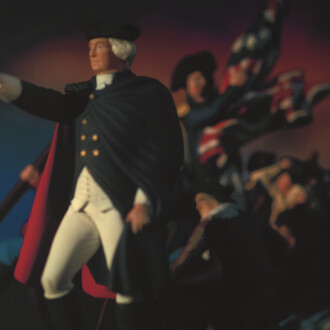Beginning on 10 May, Hauser & Wirth 18th Street will open ‘Paul McCarthy: Sculptures’ (on view through 1 June). In the gallery’s new 25,000 square foot venue, visitors will discover massive black walnut wood sculptures depicting McCarthy’s versions of characters drawn from the famous 19th century German folk tale Schneewittchen (Snow White) and his caricatures of modern interpretations of the story, including those in Disney’s beloved 1937 animated classic film ‘Snow White and the Seven Dwarfs’.
In the 2009 New York City exhibition ‘White Snow’, McCarthy unveiled his first drawings related to the Snow White theme. With their antecedents in the artist’s earlier ‘Heidi’ and ‘Pinocchio’ series, these drawings shifted a familiar European narrative back to the New World and pulled equally from iconic representations of the fairytale characters and recollections from the artist’s own life. Two years later, the 2011 New York sculpture exhibition ‘The Dwarves, The Forest’ reflected McCarthy’s fascination with the aggressive and visceral messiness of the sculptural process as it played out in his exploration of the Snow White story.
The new exhibition ‘Paul McCarthy: Sculptures’ presents the next step in McCarthy’s multi-platform mining of the Snow White story. The new works began with conventional sculpting. McCarthy developed, abandoned, reworked and ‘fucked up’ figures based upon Snow White-themed memorabilia and kitsch figurines. Subsequent bronze casting and woodcarving constituted a journey toward abstraction. In the case of the monumental work ‘Sisters’ (2013), for example, the artist passed through various stages of engagement with a single figure of Snow White. McCarthy started by building a coherent clay caricature; later, he created a second version, a near duplicate; then he combined the two. He removed the heads of these figures, scanned them to develop new versions in different sizes, and recombined the resulting array of heads with the bodies of his ‘twins’. The resulting binary work was mounted upon a platform and surrounded by an accretion of other elements in a performative attack over time. Such willful distortion suggests equally offbeat and charged psychic structures, and places such works firmly in the realm of expressionism. The final 20-foot tall, 40-foot wide bronze cast of this cumulative, baroque composition, ‘Sisters’ will stand outdoors along the Hudson River at 17th Street in West Chelsea as a complement to the sculptures inside Hauser & Wirth’s 18th Street space.
Inside the gallery, visitors will find a substantial group of large-scale walnut sculptures ranging in height from four to 14 feet. These include variations of McCarthy’s fractured fairytale characters White Snow and the Prince. Referencing his 2009 drawings as well as images from auction catalogues, illustrated books, tabloids, and pornographic magazines, McCarthy employs computer mapping of figurines to digitally flesh out and manipulate shapes and details, gradually duplicating and changing the scale of forms. His staged process ‘abstracts through merging’. Appropriating images and narratives from the culture industry, McCarthy looks to Hollywood and draws from its tactics for re-structuring reality. Like Walt Disney, he assumes the role of artist as producer, a role he also performs in ‘WS’. With the latest White Snow works, McCarthy alludes to Disney’s contribution to the Golden Age of Animation and raises questions about how an artist’s work rearranges and deranges definitions of art, culture and thought.
McCarthy’s wood sculptures also embrace the ways in which his material’s grain irregularities and color render compositions of their own. While carving ‘White Snow, Cindy’ (2012), an avatar of innocence reborn as a sexualized saint, the artist found that his material retained its living properties. Innate and unexpected details appeared and figures underwent a metamorphosis as random dark spots emerged in surprisingly strategic places. McCarthy discovered that his Snow White bore an ironic resemblance to a parallel pop culture icon and commoditized emblem of idealized femininity: the American supermodel Cindy Crawford.
Hauser & Wirth
511 West 18th Street
New York (NY) 10011 United States
Ph. +1 212 7903900
newyork@hauserwirth.com
www.hauserwirth.com
Opening hours
Tuesday - Saturday
From 10am to 6pm (Monday - Friday from 20 June 2013)











